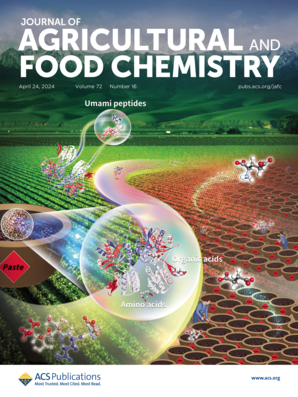Metabolic Engineering of Escherichia coli for Efficient l-Isoleucine Production based on the Citramalate Pathway
IF 5.7
1区 农林科学
Q1 AGRICULTURE, MULTIDISCIPLINARY
引用次数: 0
Abstract
l-isoleucine, a value-added branched-chain amino acid, has been widely used in the food, feed, and pharmaceutical industries. However, the production efficiency of l-isoleucine is relatively low due to the complex and inefficient biosynthetic network of the canonical threonine pathway. Here, we report the exploitation of a concise citramalate pathway for the development of an efficient l-isoleucine producer. First, chassis strain and key genes were screened for establishment of the citramalate pathway. Subsequently, a citramalate importer was identified and applied to enhance citramalate’s utilization efficiency. Finally, a plasmid-free high-l-isoleucine producer was developed by enhancement of l-isoleucine efflux, optimization of rate-limiting gene expression, and introduction of a nonoxidative glycolysis pathway. Fed-batch fermentation of the final strain in a 10-L bioreactor produced 56.6 g/L l-isoleucine with a productivity of 1.66 g/L/h, which is the highest l-isoleucine titer and productivity reported. This study paves the way for construction of efficient microbial cell factories for production of l-isoleucine and related derivatives based on the citramalate pathway.

基于柠檬酸盐途径高效生产l-异亮氨酸的大肠杆菌代谢工程
l-异亮氨酸是一种具有附加值的支链氨基酸,广泛应用于食品、饲料、医药等行业。然而,由于典型苏氨酸途径的生物合成网络复杂而低效,l-异亮氨酸的生产效率相对较低。在这里,我们报告了开发一个简洁的柠檬酸盐途径,以开发高效的l-异亮氨酸生产商。首先,筛选构建柠檬酸盐通路所需的底盘菌株和关键基因;为提高柠檬酸盐的利用效率,确定并应用了柠檬酸盐进口产品。最后,通过增强l-异亮氨酸外排,优化限速基因表达,引入非氧化糖酵解途径,构建了无质粒的高l-异亮氨酸产生物。最终菌株在10-L生物反应器中分批补料发酵产生56.6 g/L的L -异亮氨酸,产量为1.66 g/L/h,是目前报道的最高的L -异亮氨酸滴度和产量。本研究为构建高效的基于柠檬酸盐途径生产l-异亮氨酸及相关衍生物的微生物细胞工厂铺平了道路。
本文章由计算机程序翻译,如有差异,请以英文原文为准。
求助全文
约1分钟内获得全文
求助全文
来源期刊
CiteScore
9.90
自引率
8.20%
发文量
1375
审稿时长
2.3 months
期刊介绍:
The Journal of Agricultural and Food Chemistry publishes high-quality, cutting edge original research representing complete studies and research advances dealing with the chemistry and biochemistry of agriculture and food. The Journal also encourages papers with chemistry and/or biochemistry as a major component combined with biological/sensory/nutritional/toxicological evaluation related to agriculture and/or food.

 求助内容:
求助内容: 应助结果提醒方式:
应助结果提醒方式:


